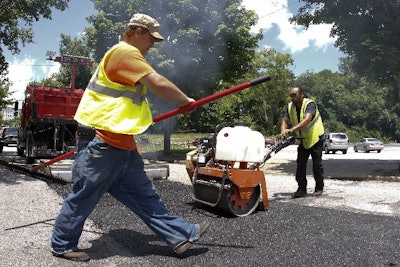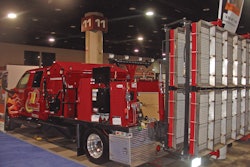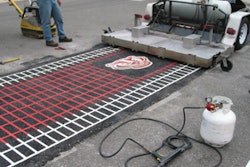
Infrared equipment has been evolving for years into the mobile and versatile units contractors are using today. What has also been evolving is the way contractors can use this equipment to expand their business and complete work more efficiently.
“In the old days, infrared was used strictly for pothole repair,” says Cliff Cameron with KM International. “The industry has evolved so much in the past 30 years and the spectrum has opened so wide, the list of uses is just enormous.”
From using infrared on new construction, to making repairs and improvements in parking lots and even in decorative applications, infrared professionals give insights on uses for the equipment you may not have thought of.
[Seamless repairs]
Making repairs and extending the life of a parking lot is what contractors normally associate with the use of infrared, but look to use it for more than just patching.
"Infrared allows the owner of the pavement to maximize the benefit of their investment in bitumen and aggregate by re-using the material instead of wasting it and buying new material, Bob Kieswetter from Heat Design Equipment. "Since repair is a non-capital item, it allows the cost to be passed onto the tenant on an annual basis, ensuring there is cash flow is there for continual maintenance, instead of waiting till the parking lot needs complete replacement."
“Traditional methods, like cold patch or saw cut remove and replace are expensive and don’t give you the best repair,” Cameron says. “When you fix it with infrared, you’re not going to have to go back and do it again.”
These units are also very small and portable so look to bring them into high traffic areas that cannot be shut down completely for paving crews or smaller areas that do not justify the expense of transporting in the heavy equipment a paving crew needs.
“Infrared units are so much less intrusive to complete repairs for business operating purposes,” Benny Shepherd, vice president of asphalt at Jarrett Builders Inc. says. His crew, based in Tennessee, use Kasi infrared units primarily for municipal work.
“With infrared, you have one unit that completes the job,” Shepherd says. “You don’t have multiple pieces of machinery and multiple trucks hauling in and out. Plus you don’t have the loud noises of saws with their dust clouds.”
[Flawless finishes]
If you’re a paving crew, you may not think you need an infrared unit in your fleet, but you might be wrong.
“Contractors are humans and they employ humans,” Krystal Strassman from Asphalt Reheat Systems says. “Humans make mistakes, things happen. Infrared can help.”
Thus infrared is a great tool to have in your arsenal, even on new pavement construction.
Strassman gives this example: A load of asphalt is stuck in traffic and it was cold by the time it was laid. Just so happens the area being paved with cold asphalt is at a main pedestrian way where drainage is exceptionally tight. Long story short, a puddle forms. A customer doesn’t want a saw cut that doesn’t match the rest of the lot. The contractor doesn’t want to drive heavy equipment over the brand new asphalt. But, the puddle needs to go away and the customer is holding money until it’s fixed. What’s a contractor to do? Use infrared. Heat the area, add some fine mix, compact and get paid. The discoloration will be minimal and the disturbance will be even less.
“When a customer is holding money for a minor repair, it is easier to make the repair, save face, avoid court and get paid. Every paving crew needs one,” Strassman adds. “One mistake, one fix with infrared and it will have paid for itself in advertising and in accounting / legal costs. You are able to solve a complaint quickly and easily, making for company look good. Word of mouth is powerful and you don’t need to heed for payment.”
Shepherd and his crew work for the large asphalt producers and paving companies in the metro-Nashville area. “We’re taking on a lot of their punch list items, fixing the screw-ups of the paver,” Shepherd says. “We take out roller marks, fixing grade issues, birdbaths or whatever is needed.
“Pre-infrared if you had a deficiency in a brand new paving job, you would either have to cut out brand new asphalt or mill it out. Now we’re able to leave everything in place and make the fix without destroying that new asphalt.”
[Time saver]
While it makes sense for a paving crew to add infrared, what about a sealcoating company? Cameron says yes.
“If they add this to their base business, they’re not going to have to wait on someone else to come and fix a repair. Instead of wasting time and potential revenue hiring someone else to do the repair when they’re available, seal coaters can just do it themselves on their calendar.”
Infrared can also be used to heat up oil spots in parking lots so sealcoat will stick to the asphalt again.
[Joint failure]
Sure infrared units can repair cracks and potholes, but what about those pesky cold seams? Drive down any major highway and the first area of failure is the joint or seam: where hot and cold asphalt meet and fail to thermally bond together.
“Taking the infrared and putting it in front of the paver or heating an existing cold joint, really adds to the structure of the road or parking lot,” Cameron says. “The cold seam is going to heat up and the paving crew can re-compact it, giving more structural integrity to the asphalt. There’s no chance for water to get back through the cold seam this way.”
“Heating the cold joint helps this thermo bond and the longitudinal joint is no longer the weakest link,” Strassman says. “Once the joints start to fail, the cost to maintain the road grows exponentially. It’s not one guy filling potholes it is five or six trucks with traffic control, lane closures, barricades, cleaning, traffic jams etc. and then of course the use of your private vehicle to run over the loose, sticky aggregate slapping your car exterior.”
All of that can be eliminated when keeping joints warm during paving, but most contractors don’t do it. “We’ve gone in and fixed jobs where the joints have failed within a year,” Shepherd says. “Keeping the joints warm during paving is definitely a better way to construct a joint, but because it’s not required by engineers and DOT’s, at the end of the day it’s only adding expense for the paving contractor. It’s hard to talk them into giving better quality at an expense unless it’s required."
"We have over a hundred contractors using joint heaters for achieving a better longitudinal joint," Kieswetter says. "The longitudinal joint is one of the biggest problem area of pavement construction, with no suitable long term repair methodology. Milling the deteriorated area and replacement of the asphalt pavement leaves two new joints to allow water penetration, and a newer technology, micro surfacing allows early reflection cracking through the repair. The infrared method leaves a sealed, compacted joint on each side of the repair. Hot-in-place longitudinal joint repair is a newer application of infrared heaters for repair and reconstruction of joints on a continuous motion, at rates of 5+ feet per minute using a total of 50 feet of infrared heaters mounted on three separate carrier units. Initially developed and tested in Canada, the state of Tennessee has just awarded a 38 mile joint repair project using the hot-in-place infrared train."
[Season extending]
In the northern part of the country, many paving and patching crews shut down once the weather gets cold. The quality of a repair drops significantly in relation to the drop in temperature as the hot mix you’re using to patch a potholes is less effective as it cools.
“To have the infrared, along with a hot box reclaimer, you’re going to have the capability lengthen the time you’re going to be able to work in a cold season,” Cameron says. “Obviously you’re going to have to work faster than when it’s warm out, but these units give you an opportunity, when others are only using cold patch, to bring your infrared in and make those emergency patches faster and more efficiently. Infrared gives you the ability to do asphalt maintenance when nobody else can, which brings your bottom line up in the off season.”
Cameron says this also gives contractors the opportunity to make more money since they’re offering a service few others can. “You’re getting a premium rate because you have this patching capability,” Cameron says.
“We’ll use our infrared units in the colder weather to help paving contractors meet deadlines,” Shepherd says. “The unit preheats the asphalt so they can go ahead and pave over the warmer surface, even in inclement weather.”
[The decorative advantage]
Sure infrared equipment can be used to repair a variety of pavement defects, such as potholes, alligatored areas and even "bird baths" in new pavement. However, the equipment can be used for improvements or additions that are thought of after the pavement has been placed as well.
Speed bumps are something that help improve the safety of a parking lot and can easily be installed with infrared. When adding things such as handicap ramps or speed bumps the infrared approach has additional benefits. If you construct a speed bump, for example, you are just adding something on to the top of the pavement. But if you use the infrared process to construct the speed bump you heat the surface, score it with a rake, and then build the speed bump on top. The bump then becomes a part of the existing pavement, making it stronger and ensuring it will last longer.
Infrared is also becoming the standard go-to for thermoplastic application. Greg Larsen, president of ThermOTrack says that it’s important to be able to monitor the heating process when using infrared on thermoplastic application to avoid burning or marking the thermoplastic design. “The up and down element adjustment on these units can deliver a significant reduction in heat intensity allowing for a more controlled, even process,” Larsen says.
"The ability of infrared wavelengths to effectively penetrate dense objects has made it particularly useful in preformed thermoplastic application," Kieswetter says. "Infrared wavelengths heat fairly evenly throughout the thickness of the thermoplastic, virtually eliminating the problems with burning the top of the material and bonding to the surface that are associated using a flame torch application method. It also allows for consistent heating of a larger surface area depending on equipment size."
“You can have any graphic created for pavement, from parking lots to airport runways, and use the infrared unit to heat it up and bond it into the asphalt,” Cameron says. “The thermoplastic absorbs into the asphalt to create a design that’s so much brighter and more reflective than paint.
“The cost of thermoplastic is competitive with paint in terms of the amount of years these graphics will last before you have to reapply it. With paint you have to go back every few years, but the life cycle of thermoplastic graphics is much longer.”
On top of thermoplastic, Larsen says decorative stamped asphalt is gaining popularity. “The cost of stamped asphalt is dramatically less than stamped concrete or paving stones,” Larsen says. “Stamped asphalt has a continuous surface and is more flexible and repairable than stamped concrete or paving stones. Plus the decorative patterns will generally last for the life of the asphalt's surface”
Strassman also adds she’s seen infrared be used to remove tile and also melt manure in barns as an easy means of disposal.
Do you use infrared for an application not listed here? Let us know at [email protected]



















